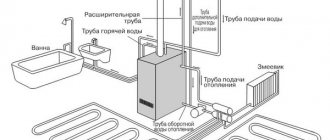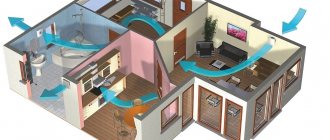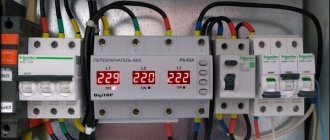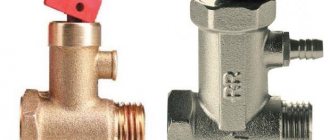- Operation of a double-circuit gas boiler with a flow-through heater
Such heating devices have become widespread. Due to their small size, excellent power characteristics and ease of maintenance, they are increasingly used for heating. In addition, the cost of gas is now much lower than alternative fuel sources. The design allows you to simultaneously heat the living space and heat water, which eliminates the need to purchase a water heater separately. If you decide to install such equipment, you should find out all the nuances of the installation and find out how a double-circuit gas boiler works.
How does a device serve two circuits work?
This heat generator, when compared with the single-circuit version, is equipped with two heat exchangers. According to established technical terminology, they are called primary and secondary. One is located in the fire burning zone itself. It is used to heat the fluid for the system. The second is responsible for the functioning of the hot water supply. And that's just the basics.
The unit consists of numerous interconnected units that perform various actions. There is no need to disassemble it thoroughly. It is enough to understand that only well-coordinated interaction can guarantee long-term and problem-free use, and to know about the most important elements.
To understand what a double-circuit gas boiler is, you should examine in detail the structure of its main components.
Types of burners
These devices heat water and generate heat for heating. When fuel is burned, energy is produced. The device is located in a compartment into which gas and air are pumped to ensure the combustion process.
Classification by operating modes:
- Single-level. Units equipped with such devices can only operate in two positions: “start” and “stop”. They are not economical and quickly break down, but are popular due to their simplicity of design and low cost.
- Two-level. Generators equipped with elements of this type can operate at both full and half power. This feature is a tangible advantage, since there is no need to use the device at full capacity in the summer.
- Modulated. The smart boiler system allows you to customize and regulate the intensity. These units are characterized by efficiency and a very long service life.
Burners can be open or closed. In the first option, oxygen comes from the room in which the heating apparatus is installed. To prevent combustion waste from entering the living area, a chimney is used to provide exhaust.
Atmospheric heat generators are equipped with a metal pipe. The smoke duct is usually mounted in a vertical position or at an angle.
Turbocharged variations are equipped with closed chambers. They are considered very reliable, but they are complex in functionality and are expensive. In addition to the smoke exhaust, a channel is needed through which oxygen enters the chamber. Therefore, units of this type are equipped with coaxial pipes, since they need not only to remove smoke, but also to draw in air.
All models contain fans, protective systems and automation. The generators listed above require electricity to operate. Energy dependence, due to which operating costs increase significantly, is their main disadvantage.
Types of heat exchangers
These devices receive heat and transfer it to the wearer. The primary is located above the burner and has the shape of a finned, curved serpentine tube. Under the influence of fire, the temperature of the liquid rises and begins to move towards the heating distribution.
The secondary consists of plates and two pairs of pipes. Water flows through one of them, the other is intended for the movement of coolant along the heating circuit. Such a system is called dual.
In addition, there are generators with a bithermal heat exchange mechanism made from copper. This is a pair of pipes located one above the other. The carrier is redirected along the outer one, and the solution for hot water supply is redirected through the inner one. Such units are difficult to operate; due to their configuration, it is not easy to clean them from contamination. Accordingly, you need to know how to properly use a double-circuit boiler. But thanks to their mobility and high heating rate, they are in good demand.
Automation and control unit
The automatically operating mechanism ensures stable and safe operation. Controls the water temperature in the water supply system of the heat exchanger. In emergency situations, it prevents the heating device from operating.
It stops turning on if:
- gas pressure has decreased;
- suddenly no traction;
- overheating has occurred.
The ECU coordinates protection and process automation devices. Consists of several switches, microcircuits and their combinations.
Intelligent control is a hallmark of modern generators with different operating characteristics.
Chimney design
The chimney structure of a gas boiler is extremely important for the operation of the boiler, since it is thanks to it that combustion products are removed from the apparatus. True, it is a tube, and there are no special devices in it. However, they come in different types:
- Metal. They are sandwich panels made of lines of different diameters, made of stainless steel. The voids between them are usually filled with a basalt thermal insulation layer. They are highly reliable. They are multi-layered and have high heat-insulating properties. But they are assembled from a large number of parts, which is not entirely convenient.
- Ceramic. Simpler, but no less durable models. They even resist the effects of chemical substances. They are ceramic pipes wrapped in mineral wool. However, they require additional installation of condenser collectors.
- Coaxial chimney. Easy to use and looks great. Does not require installation of any additional devices. Condensation does not accumulate, which is also its advantage. And it is something like a pipe-within-a-pipe design. Can be used for closed type boilers (those that take air from the street. Open systems take air from the house). That is, air enters the boiler through the outer pipe, and exits through the inner pipe, being exhausted.
Coaxial chimney
Previously, a brick chimney was quite popular. But they are quite difficult to install, and they are quite bulky.
In what modes can it function?
Or how a wall-mounted double-circuit gas boiler works in summer and winter. Its activities are carried out in two variations:
- Winter. All systems of the unit are activated - the coolant is heated, heated water is prepared according to the parameters.
- Summer. During the hot season, the heating circuit is switched off, only DHW heating is active.
The decision to change the position (when to turn it off and on) is made by the user; this is an elementary action that does not require the presence of a specialist. The supply of boiling water is necessary constantly, because of this the perimeter of the water supply operates uninterruptedly. If the need arises, you can turn it off.
There is another mode - protective. It prevents freezing when the temperature drops sharply to the set level. In critical situations, increased circulation is started, the pump begins to circulate the liquid at high speed, preventing it from freezing. For Russian regions this is very important, given the climatic conditions. Thawed pipes are a common problem.
Positioning the thermometer correctly
There are two types of thermostat:
- Built-in - measures the temperature of the coolant, does not respond to external conditions.
- Remote - measures the air temperature in the room, does not react to the temperature inside the boiler.
With the first type, everything is clear - nothing can be changed, the thermometer does not involve transfer. The remote type must be positioned correctly - otherwise, every ventilation or operation of household appliances will disrupt the heating operation throughout the house.
Experienced craftsmen advise placing the device in the part of the room that cools most slowly. As a rule, it is located at a considerable distance from the boiler, so heating is also extended over time. Reducing the temperature to the lower limit will mean cooling the entire room - the heating will begin to operate normally.
In order for the burner to perform long, uniform cycles, you should not install a thermometer:
- Near windows, doors, cracks in walls.
- Near household appliances.
- Close to the floor or ceiling.
- In the basements.
Basics and specifics of operation
Few people think about the diagrams and operating principles of a wall-mounted double-circuit gas heating boiler. The heating circuit and water do not heat up at the same time. The unit operates in normal mode only to heat the contents moving through the system. The frequency of switching on and the intensity of the fire is controlled by a temperature sensor. At the same time as the burner, the circulation pump starts, if natural movement is not provided for in the process.
When the temperature rises to a certain level, the meter transmits a signal indicating a decrease in the activity of the heat generator. Until it drops again to a predetermined value, the device remains inactive.
Pump
Pump in a gas boiler
Serves to impart movement to the coolant. This device causes heating fluid to circulate from the heated primary heat exchanger to the radiators, heat them and move back to heat them. The pump usually has several speeds and is adjusted by a service engineer based on the size of your heating system.
Too high a pump speed can create additional noise and reduce the efficiency of the boiler. And too small will lead to uneven heating of the radiators. Therefore, for proper setup, it is very important to contact qualified service engineers.
Diagram of operation of a device serving two circuits
It is not possible to use a dual-circuit device to simultaneously heat the room and water supply. As soon as the water tap is activated, the movement of the coolant through the heating mechanism stops.
If the heated liquid is used for household purposes in too large quantities, the possibility of interruption in the operation of the boiler in terms of heating cannot be ruled out. There are two ways to get out of this situation: install a more powerful unit or add a boiler to the complex.
If DHW is used intensively, it would be optimal to install a device with a built-in heating device. Fuel consumption will, of course, increase, but not by much. This is explained by the fact that in the intervals between functional cycles the burner ensures that the temperature of the water in the additional water heater is maintained.
The reserves located in the built-in boiler make it possible to use water without turning off the heating circuit, which allows you to obtain the required temperature at the right time, automatically providing a sufficient amount.
Operation of a double-circuit gas boiler with a flow-through heater
In this case, a plate heat exchanger is used, which is characterized by high efficiency but low productivity. It passes two flows in a perpendicular direction between metal plates, which are aligned in such a way that the flows do not mix. The large area provides good heat transfer, which allows you to heat water in the process (on the go).
With a compact size, the design increases the temperature level to 50° and even higher, which is typical only for highly efficient units.
As disadvantages, it should be noted the unstable heating mode and mandatory regular cleaning of limescale.
Operating principle of a double-circuit gas boiler with a biothermal heat exchanger
This device is in the form of a coil, presented in the form of a coaxial pipe. Simply put, two pipelines inserted into each other. The coolant moves through the external volume, and the liquid for hot water supply moves through the internal volume. This heating method significantly changes the quality characteristics of the work. The supply of hot water increases and efficiency increases, which is perfect for meeting the needs of a large family.
A noticeable disadvantage of such a heat exchanger is the complexity of its structure, which makes flushing difficult.
You should not forget to promptly remove lime deposits that quickly accumulate on the surface of the pipe. Otherwise, the section will be completely blocked. In addition, the thicker the plaque layer, the lower the heating activity. Accumulated contaminants turn into a heat insulator. When adjusting the operation of the heating device, you have to constantly increase the fuel supply. Under such conditions, the device very soon fails. This is facilitated by internal scale and systematic overheating.
Not all service centers undertake to flush the unit. In some particularly difficult situations, it is easier to change the generator than to fix it. The disadvantages of biothermal structures are mainly due to improper operation. If we consider this installation in terms of productivity, it is quite suitable for use.
AnswersMail.Ru Gas boiler clocking. On time
what is 17 kilowatts of coolant?
should it be 17 kilowatts of coolant in liters? This parameter is the OK losses and in double-circuit ones, the consumption for heating DHW. The on/off time depends on the temperature of the coolant and the internal temperature of the room.
Clocking the boiler, in principle, does not interfere with its operation, but the less often it turns off, the better. The boiler needs to be adjusted to the system or immediately select the boiler power for the heating system. You can reduce the power by going to the engineering menu or inviting a specialist so as not to mess things up yourself.
from home conditions and from the weather and from the sensitivity of the boiler....
Classification
The answer to the question of how a double-circuit gas boiler works varies depending on its type. According to the installation method, devices are divided into:
- Wall-mounted. These are small-sized devices of moderate and low power. As a rule, they are installed in small houses.
- Floor-standing. They are massive, so their location requires more space. Despite the dimensional inconveniences, such units can simultaneously support the activity of hot water supply and warm up a large area of the room.
According to the layout:
- Atmospheric. They are placed next to the chimney, taking air from the room in which the device is installed. Window openings and good ventilation are required.
- Turbocharged. The operation of this boiler is independent of draft, since combustion waste is removed by a fan powered by electricity.
Functional division:
- Single-circuit. Heating work.
- Dual-circuit. Equipped with 2 radiators. Maintain the operation of the heating system and fill the taps with hot water.
By type of burner:
- Simulated. Features automatic flame control.
- Regular. Complete lack of independent regulation.
By type of ignition:
- Piezo ignition. The unit is turned on by pressing a button and changing the position of the piezoelectric element. Characterized by energy independence. Among the shortcomings it is worth noting: impressive fuel consumption, the need for manual action.
- Electronic. The built-in transformer, controlled by automation, is triggered.
According to the principle of operation:
- Convection. In this standard design, heat is transferred to water during combustion.
- Condensation. The temperature of the water vapor is involved.
Device, main components
A standard gas fuel heating boiler includes the following main operating units:
- Burner.
Carries out gas combustion and uniform distribution of the generated heat to the heat exchange circuit. It can be conventionally atmospheric or turbocharged - equipped with forced exhaust of combustion products.
- Heat exchanger.
It is a box with a curved tube located inside through which water passes for heating. Divided into single- and double-circuit. Made from copper, steel and cast iron.
- Circulation pump.
Provides constant water pressure in the pipeline for its optimal distribution throughout the system.
- Expansion tank.
Prevents emergency expansion of water and its vapors inside the system.
- Smoke exhaust.
Carries out the removal of combustion products to the outside. It can be conventional - atmospheric, as well as turbocharged - with a fan for forced exhaust of gases to the street.
- Control block.
Provides configuration of system operating parameters. Connects wires, sensors, sensors, electrical circuits.
Gas boiler control module Source stroy-podskazka.ru
- Sensors for automatic control of safety parameters.
Gas automation for boilers monitors the stability of operating parameters and the safety of the system. Prevents the development of an emergency situation for various reasons - overheating, traction shutdown, loss of flame in the burner, etc.
Advice! A standard double-circuit boiler produces up to 8 liters of domestic hot water per minute. If higher consumption is required, it is better to install a single-circuit model combined with a storage water heater. The volume of household boilers varies widely - from 50 to 300 liters. This is quite enough for the everyday needs of a private home.
Boiler powered by a gas boiler Source domkotlov.by
Installation Features
Installation of this type of equipment is a very responsible matter. To ensure its proper functioning and your own safety, you must approach this issue with the utmost care. First of all, you should pay attention to the following points:
- The place where it is planned to install the boiler must comply with all regulatory parameters. It is necessary to coordinate its location in advance with representatives of the gas service.
- The connection project is initially drawn up on paper and then sent for approval to the appropriate organization.
- After receiving permission, its employees will personally install the necessary metering devices to monitor fuel consumption.
- Before starting installation, you need to make sure that the unit is fully equipped. If some parts are missing, such a device cannot be installed. This may lead to an emergency situation.
- First of all, installation points are determined on the wall surfaces, only then do they begin the phased installation of all elements.
- Upon completion of the installation activities, the system is connected in series. Test filling the circuit with water, then heat the boiler.
- If you find any problems or smell gas, you should not try to fix the problem yourself. In such cases, you should immediately call a specialist who will assess the condition of the structure on the spot and carry out the necessary repair work.
What to do when a malfunction occurs?
Gas consumers should understand that they do not have the right, but the obligation, to repair their home or apartment equipment. Moreover, in a timely manner and with high quality.
And since frequent shutdown of the boiler is potentially a malfunction, this legal requirement cannot be ignored. Since for this, according to Art. 9.23 of the Administrative Code faces a fine.
Repairing any gas equipment is a responsible procedure, as it significantly affects safety. Therefore, you should not overestimate your capabilities or try to save money, risking the lives and health of people nearby, including relatives and friends.
The size is 1-2 thousand rubles. And, if suddenly the situation, through the fault of the user, becomes dangerous to the life and health of people or an accident occurs, then you will have to part with 10-30 thousand rubles (Article 9.23 of the Administrative Code).
It is easier and more reliable to contact the gas company with which the contract has been signed. And all the risks will fall on their shoulders. As well as responsibility for the timeliness and quality of repairs. And for violations the company will be held liable in accordance with Art. 9.23 Code of Administrative Offences. Where is it said that penalties can reach an impressive 200 thousand rubles
You should also remember that you should not take responsibility for yourself by trying to eliminate the cause of switching on/off yourself. Especially against the backdrop of the fact that problems with equipment inoperability must be resolved by specialists from companies with which the gas consumer has signed an agreement. And for ignoring such a rule, additional sanctions in the amount of 1-2 thousand rubles are threatened - this is also stated in Art. 9.23 Code of Administrative Offences.
Any repeated violation of the above norms will be the reason for punishment in the form of a fine, the amount of which will be 2-5 thousand. The basis for this is the corresponding norm in the above article of the Code of Administrative Offenses.
Where can I buy
Having figured out the design of a double-circuit wall-mounted gas boiler, you should think about purchasing it. Additionally, you will need a chimney kit.
Among those that have proven themselves in this market, one can note one of the largest manufacturers of chimneys in Russia - Industrial. Thanks to the latest metalworking tools and a careful approach to the selection of raw materials, it produces only high-quality products.
The undeniable advantages of FERRUM chimneys:
- They are not inferior in quality to European analogues, but cost 2 times less.
- Suitable for any heating devices.
- They are easy to install.
- Manufactured from stainless, heat-resistant steel.
- Average service life is 20 years.
You can get all the necessary information and find out prices for chimneys by calling the phone number listed on the official website of PC Ferrum.
Sensitivity is the key to rapid wear.
Of course, everyone likes a comfortable temperature. Modern systems offer fine-tuning of heat exchangers that are able to maintain a strictly specified temperature in the room.
With volumetric gas boilers, everything is clear - 100 or 200 liters of water will take an extremely long time to cool, even by one degree. However, the situation is completely different with wall-mounted appliances with a volume of up to 10-12 liters. There the count goes on in minutes, which causes clocking. The situation is especially typical during the off-season.
Near-zero temperatures outside the window are a difficult problem for boiler automation. Heat transfer to the environment is not strong enough for constant operation even at low powers, but still manifests itself in the absence of heating. A small range of 2-4 degrees causes constant starting and interruption of the cycle, which significantly wears out the boiler. The right decision would be to increase the spread to 10-12 degrees.
Gas pipe in the kitchen - how to hide and decorate it? Photos of examples of ready-made solutions.
The kitchen is often the main place in the house where people spend most of their time - cooking, eating, meeting and socializing. That is why, when renovating it, you want to get the perfect result, create coziness and comfort.
Therefore, it is important at this stage to think through the entire ergonomics of the space. While making a sufficient number of sockets is not a problem, the communications in the kitchen in the form of various pipes create a number of problems when carrying out repairs.
If water or sewer pipes can be moved, hidden under a screed or in a wall, or hidden behind a curtain in the case of a heating pipe, then in most cases this will not work with a gas pipe.
According to existing standards, it is strictly forbidden to close a gas pipe “tightly.” Free access to it must be provided, otherwise during inspection you will be fined and forced to break the structures covering the pipe.
You cannot shorten the gas pipe in the kitchen yourself; you cannot move it to another place - approval and permission from gas services is required.
And in some cases this is simply not possible, for example, if the pipe runs throughout almost the entire kitchen area. But even if all the necessary permits for changes have been obtained, it will still not be possible to completely cut off the gas pipe in the kitchen.
This begs the question, what to do in this case, what to do so that the pipe does not spoil the appearance of the kitchen. Don't despair. There are a lot of options for hiding a gas pipe in the kitchen. Moreover, most of them will not require large expenses. Let's look at the main ones.
The easiest and cheapest way to hide a pipe in an existing interior is decoration. You can do it yourself, or use the services of a decorator. Available materials are used for decoration, and the result will impress you.
Is it possible to place a refrigerator next to a gas pipe, what will a specialist say?
It is well known that it is not recommended to place the refrigerator next to objects that emit heat: heating radiators, ovens and hobs. It is clear that if there is a gas stove in the kitchen, the refrigerator should be located at a remote distance from it, but is it possible to place the refrigerator next to the gas pipe?
To answer this question, you should consider the risk factors that arise during the operation of the refrigerator and correlate their danger when exposed to the gas pipeline.
Refrigerator operating principle and risk factors
The refrigerator works by extracting heat from the refrigeration chamber by passing through it a cold liquid refrigerant (freon), which evaporates when thermal energy is taken. Then following the condenser system of the refrigerator in the form of a thin serpentine tube on the back wall, the freon gas cools, releasing heat to the environment.
The refrigerant enters the compressor in the form of condensate, after which it is compressed (at the same time its temperature becomes below zero) and supplied to the refrigeration chamber in a liquid state.
The compressor itself operates from an alternating current network and is an electric motor, on the shaft of which there is a special type of nozzle that compresses the freon condensate entering the working chamber.
Thus, there are two factors that present some risk when operating a refrigerator: the warm surface of the condenser coil on the back wall and the electrical supply to the compressor.
Rice. 1 Refrigerator in the kitchen - examples of location
Flexible gas supply - which one to choose and how to connect. The article covers such topics as whether it is possible to connect a gas stove yourself, what is the best way to connect it, as well as the stages of connecting it yourself.
Is it possible to place a refrigerator next to a gas pipe - an expert’s answer
If measurement is not possible, the temperature on the back wall of the refrigerator can be calculated in a simple way: it consists of the sum of the room temperature and the difference between the ambient temperature and the air in the refrigerator compartment. Thus, with the warmest air in the kitchen being 25 degrees, this value will not exceed 55 - 58 degrees (in practice, taking into account losses of 50 degrees, this is the maximum value).
Considering that the back wall of the refrigerator is usually located at a minimum distance of 20 - 30 mm. from the pipe, this factor will not affect the gas pipeline system in any way, even if it is tightly connected to the pipe and the temperature is several times higher.
The second risk factor is the presence of an electric compressor power cable with an alternating voltage of 220 volts in the gas pipe area. Here it may seem to an ignorant person that if the cable breaks or other malfunctions, current will flow into the pipe, a spark will ignite and an explosion will occur. This assumption is groundless for the following reasons:
- The gas pipeline pipes are made of metal and go into the ground, so when they come into contact with the electric drive, the phase will be grounded, and if the machine does not turn off the electricity in the apartment, the gas pipe will in any case be de-energized as a result of grounding.
- If the underwater hose is made of rubber and cannot be grounded, and contact of the exposed electrical wire from the refrigerator occurs in the area of the stove, then in this case the current will go to the grounding bus. The fact is that modern gas stoves are connected to a power source via sockets with three connectors with a protective neutral wire.
- If the gas stove is working properly, and the connections in the underwater hoses are reliably insulated and do not allow gas to pass through, there is no danger even if there is a break in the electrical wire of the refrigerator, other than electric shock to the owners themselves.
The boiler immediately goes out after ignition: causes and solutions
If you lit a boiler (this does not always work the first time) and it goes out after a few seconds, then there are many more reasons for this. It is especially dangerous when the boiler goes out due to automatic operation, while the gas supply does not stop.
Why is this happening?
There are several reasons:
- Clogged chimney - the problem most often occurs in private homes where powerful boilers are installed. If there is soot and other blockages in the chimney, the draft is disrupted and the boiler instantly turns off in emergency mode.
- The thermocouple does not work - contamination may be in the hood, especially in winter, when the steam coming out of it quickly condenses and settles on the walls in the form of a dense crust of ice. The thermocouple may fail if the boiler is often used at maximum power.
- Contamination in the igniter - the boiler turns on for literally a second and immediately goes out, there is no flame in the burner, and re-ignition is not successful. This happens if the boiler is used extremely rarely, for example at the dacha.
- Failure of the gas pressure valve - its emergency operation for no apparent reason leads to the cessation of gas supply to the burner, and accordingly the boiler immediately goes out.
If the pressure valve and igniter are faulty, then after turning on the boiler there is a high probability of a gas leak developing. Always check the serviceability of gas equipment before using it actively.
What can be done?
Diagnosis of faults in this case is the prerogative of specialists. It is strictly forbidden to open gas equipment, carry out inspections and repairs on your own. This should only be performed by an authorized technician.
You can only check the blockage yourself by shining a flashlight into the hood. Further actions are aimed at cleaning the nozzle, assessing the performance of the igniter and monitoring the operation of the thermocouple. The serviceability of the pressure valve must be checked.
BAXI Forum
The largest professional forum BAXI in Russia
- Unanswered topics
- Active topics
- Search
- Users
- our team
- Acknowledgments
- 11/15/2019 — A separate section on the forum has been allocated for discussion of the ZONT device.
- 07/19/2019 — The BAXI seminar book 3Q was published. 2019 (119 MB). Download
- 06/20/2019 — BAXI Energy voltage stabilizers are on sale.
- 04/16/2019 — Sales of BAXI Eco Nova boilers have started.
- 11/16/2018 — The BAXI 4Q seminar notebook was published. 2018 (8 MB). Download
The optimal solution is a heat accumulator
Sometimes the tips listed may not work: the user is interested in a narrow temperature range, the temperature sensor is built-in, and the minimum boiler power exceeds the required by four times. It would seem that timing cannot be avoided. In this case, it is worth moving from fine adjustments to making design changes to the heating system.
The essence of the problem is the heating and cooling of the coolant too quickly. This is observed due to a combination of two or three factors:
- Spacious room
- Powerful boiler
- Not enough coolant
The first two cannot be fixed, but these are secondary problems. Low coolant content in the network is a key drawback causing clocking. It’s easy to get rid of it - just introduce new elements into the heating.
A heat accumulator is a sealed tank with water or other coolant with a volume of 100 liters or more. It is installed directly at the outlet of the heater, connecting it to the rest of the pipe system.
The result is the following process:
- When turned on, the boiler warms itself up.
- The battery stores heat over a significant period of time.
- The rest of the heating system warms up.
- The automation turns off the boiler.
- The battery distributes heat over a significant period of time, maintaining a constant temperature.
- The cycle repeats.
Of course, the battery increases inertia - therefore it is recommended to connect it parallel to the main pipe, with the possibility of excluding it from the system. Thus, the clocking problem is solved comprehensively and is unlikely to return again.
Prevention measures
Breakdowns of gas equipment happen to everyone; it is impossible to insure against this.
However, there are a number of ways to reduce the risk of breakdowns:
- Scheduled diagnostics of gas equipment before the start of the heating season - a specialist will conduct an inspection, do a test run and tell you about all the nuances of this boiler.
- Selection of the correct operating mode of the boiler and pump.
- Periodic cleaning of all combustion chamber elements is carried out only by a specialist.
vote
Article rating
Adjustment, adjustment of the Honeywell gas valve
Gas valve Honeywell gas boiler.
The yellow connector with wires is installed on the stepper motor. Some modern boilers, such as Protherm Gepard and Protherm Panther, have Honeywell gas valves.
The gas pressure setting at the outlet of the Honeywell gas valve is changed using a stepper motor. The gas valve stepper motor is controlled from the boiler control panel through the service menu.
Products for construction and repair
⇆
Let's look at setting up a gas valve with a stepper motor through the service menu using the example of gas boilers Protherm Gepard and Protherm Panther.
Norms for the location and rules for moving gas pipes in the kitchen
Most of the goodies on the tables appear with the help of a natural gift - gas. Naturally, the owners of the house want blue fuel to enter the kitchen unnoticed, without destroying the harmony, integrity of design and style, which has been thought out for months. Meanwhile, utility networks are not a toy, you cannot joke with them, because in the pursuit of beauty you can lose the main thing - life. So, how and where should a gas pipe be installed in the kitchen: norms and rules for handling the system.
General standards
First, it’s worth finding out under what circumstances gas pipes are used in the kitchen. The use of blue fuel in such a room most often means installing a stove. It's time to familiarize yourself with the terms of use. So, remember the main postulates:
- gas stoves are allowed to be installed in kitchens with a height of 2.2 meters (if the ceiling in the room is sloped, then to install the stove you should choose a place where it reaches the established norm);
- the kitchen should be equipped with a window with a window so that during the day repair work can be carried out without artificial lighting, ventilating the room (the presence of a functioning ventilation duct is welcome);
- between the slab and the opposite wall there must certainly be a passage with a width of 1 meter;
- ceilings and walls made of materials prone to combustion, according to standards, must be covered with plaster;
- The stove can be used in kitchens separated from the corridor by a secure wall/partition and door;
- The installation of gas pipes in the kitchen should be done so that the distance between the walls and the stove is at least 7 centimeters;
- branching to the slab is allowed only at the level of the connecting fitting;
- the shut-off valve should be installed at a level of 1.5 meters from the floor and at a distance of 20 centimeters from the side of the stove;
- To install the stove, it is permissible to use a special (heat-resistant - from 120 degrees) flexible hose and do not forget to change it, based on the recommendations specified in the product data sheet.











